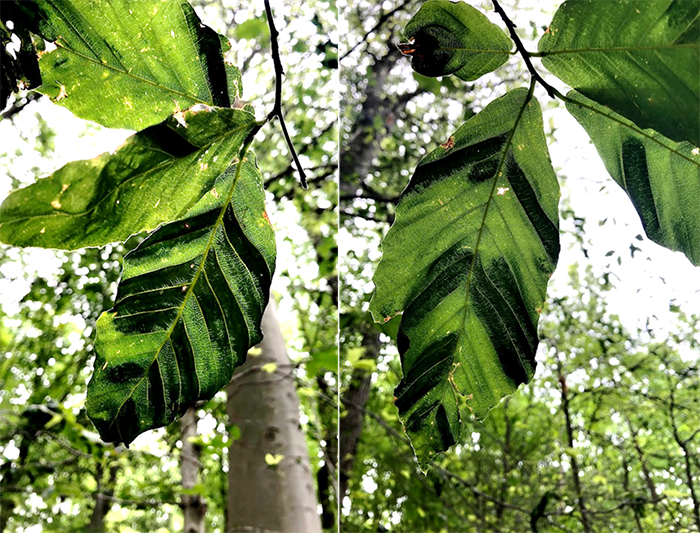Beech Leaf Disease in New Jersey: What Homeowners Need to Know and How to Protect Your Trees
 July 2, 2025 12:00 pm
July 2, 2025 12:00 pm
Beech Leaf Disease (BLD) is rapidly becoming one of the most devastating tree health threats in the northeastern United States. Detected first in Ohio in 2012, it has since spread through the region and is now causing major losses in Monmouth County, New Jersey. At Frontier Tree, we are seeing widespread infection in both American and European beech trees, and many homeowners remain unaware of the danger.
This disease can kill mature trees in as little as 6–10 years, and small saplings may die in just 1–2 years. Understanding this problem—and acting early—is the key to protecting your landscape.
What Is Beech Leaf Disease and What Causes It?
Beech Leaf Disease is caused by an invasive nematode species called Litylenchus crenatae subsp. mccannii. This microscopic roundworm infects the leaf and bud tissue of beech trees. Unlike other nematodes that live in soil, this species invades leaf tissue during the bud stage and continues its life cycle within the canopy.
This nematode is not visible to the naked eye but causes highly visible symptoms. Infection is believed to be spread by wind, rain, insects, birds, and even human movement of nursery stock.
How to Identify Beech Leaf Disease Symptoms
The most recognizable symptom is opaque banding between the veins of beech leaves. When held up to the light, infected leaves show these distinctive bands as darker, less translucent areas. Other symptoms include:
- Thickened or curled leaves
- Yellowing and shriveling foliage
- Premature leaf drop starting in the lower canopy
- Smaller, stunted, or aborted buds
- Crown thinning and branch dieback
Once these signs are visible, action is urgently needed. Without treatment, beech trees will decline rapidly.
What Beech Trees Are Affected in New Jersey?
Beech Leaf Disease in New Jersey impacts several species:
- American Beech (Fagus grandifolia) – Common in forests and residential landscapes
- European Beech (F. sylvatica) – Popular ornamental tree with many cultivars
- Oriental Beech (F. orientalis) and Chinese Beech (F. engleriana) – Less common but still vulnerable
These trees play vital ecological roles, providing food, shelter, and climate regulation. Their loss would disrupt local biodiversity and soil health.
How Beech Leaf Disease Spreads
The nematode overwinters in buds and spreads most actively from mid-summer through early fall. During this time, it can be dispersed by:
- Rain and water runoff
- Native insects like the beech blight aphid and white-marked tussock moth
- Birds and wildlife using trees for shelter
- Wind-driven movement up to 38 feet
- Human transport of infected material
Because of this, isolated trees in landscapes are still at risk even if they appear healthy.
Beech Tree Disease Treatment Options
At Frontier Tree, we use the latest research and proven products for beech tree disease treatment. While all options are still being studied, current best practices include:
Thiabendazole Injections (Arbotect 20-S)
This is the most effective treatment currently available. It’s injected into the tree and significantly reduces nematode populations. Effective for trees with less than 50% dieback.
Fluopyram Foliar Sprays (Broadform)
These organic pest control solutions for long-term protection are used to suppress nematodes in younger, smaller trees. Four applications per season are recommended.
Potassium Phosphite Soil Drench (PolyPhosphite-30)
Stimulates natural defenses and improves tree health, especially in saplings or smaller specimens.
Why Treatment Works Better in Landscapes Than Forests
Forest-wide management is impractical. But landscape tree health solutions like fertilization, watering, pruning, and ongoing health checks can greatly improve outcomes in suburban and residential settings. This is why homeowners in Monmouth County must act now.
Additional Strategies to Manage BLD
When treatment isn’t possible, you can still take action to protect your property:
- Avoid pruning large limbs, which may worsen decline
- Keep tree roots healthy by limiting traffic and soil compaction
- Mulch appropriately—no volcano mulching, and use under 2 inches
- Provide ample water during dry periods
- Underplant with native tree species such as black gum, white oak, and hickory to preserve ecosystem functions
Why Frontier Tree Is Your Partner in Beech Tree Health
At Frontier Tree, we are leading the way in beech leaf disease treatment options across Monmouth County. We offer:
- Expert litylenchus crenatae mccannii management
- Certified arborists using phosphite and fluopyram for BLD
- Tree injections with Arbotect 20-S for large specimens
- Safe, effective landscape tree health solutions tailored to your needs
We are already treating dozens of landscape beeches for customers who were lucky enough to detect this disease early.
Act Now to Save Your Beech Trees
Beech trees are essential to our landscape’s beauty and ecological balance. If you suspect beech leaf disease in your New Jersey property, don’t wait. Contact Frontier Tree today for a professional inspection, diagnosis, and treatment plan.
Preserve your trees. Protect your property. Partner with the experts.
Categorised in: Uncategorized
